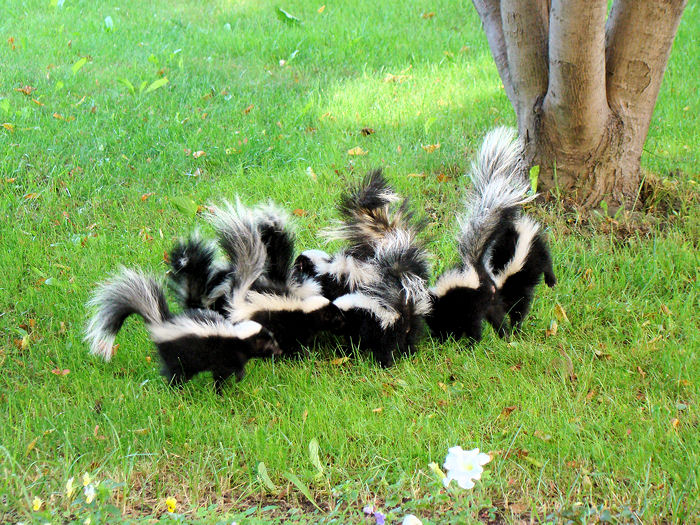Many people know skunks by their stench and their stripes. While there are actually five different skunk species in the U.S., the striped skunk is the most well-known in North America. The other species do not have the same striped pattern which is one of the main ways people describe skunks! These creatures are shy, mellow, and fascinating. Here are six skunk facts you may not know.
1. Skunks Are Named After Their Smell
The scientific family name for skunks is Mephitidae. Skunks and stink badgers are a part of this wildlife group, and every animal in it has one thing in common. They all have anal glands that can spray a noxious liquid as a form of defense. The term Mephitidae means “stink.”
Initially, skunks were lumped into the family Mustelidae, which means “musty.” This family consists of ferrets, badgers, otters, weasels, and other critters that emit a similar unpleasant stench. However, skunks and stink badgers are also genetically distinct from the Mustelidae, earning them their own family name.
2. The Stripes on a Skunk’s Back Point to Its Sprayer
Animal coloration often serves a purpose. The color may serve as camouflage. It may make one sex more appealing to another. It can help distinguish the young from the mature. It can mimic the coloration of a dangerous animal, tricking would-be predators into thinking they need to steer clear.
Skunks are nocturnal creatures, which means they are most active at night. You would think that the black coloration might be for camouflage if it weren’t for the bright white stripes! Those stripes send a message, though. They point directly to the scent glands, warning potential predators to beware.
3. Skunk Spray Evolved Because They Are Nocturnal
Skunks are solitary critters with poor eyesight. They also don’t move very fast. These characteristics make them vulnerable to nocturnal predators such as large cats and birds of prey.
It turns out that spraying a potent, hard to remove and temporarily debilitating spray is a pretty good defense for an animal with few other options. Skunks are no physical match for nature’s top carnivores, but they tend to leave skunks alone because of their spray.
4. Skunks Can Spray up to 15 Feet
When a skunk takes aim, you may think its target has to be in close quarters, but that isn’t the case. Those anal glands can reach up to 15 feet. When the threat is within 12 feet, the stink-wielding creature is entirely accurate with its aim. How exactly do skunks spray? Their anal glands contract and release, shooting the liquid out in a stream or mist.
5. Skunk Spray Can Be Dangerous
The stink in the spray is from the chemical compounds made primarily from sulfur. If the spray gets in the eyes, it can cause irritation, itching, and burning. It may also lead to temporary blindness, giving the skunk a head start in making its getaway. Some people are sensitive to skunk spray and experience nausea or vomiting. The effects are not long-lasting, and the spray is not poisonous or toxic.
6. Skunks Can Be Pets
While you don’t want to attempt capturing a wild skunk and turning it into a pet, skunks that are bred in captivity can be pets. Wisconsin is one of only 17 states that permit people to have domesticated skunks as pets. When bred as pets, the animal’s glands are removed, making it vulnerable if the skunk gets out. A pet skunk that escapes also lacks the ability to make its way back home.
Skunk Help in Milwaukee
Skunks are one of many types of wildlife in Milwaukee, but you may not want a wild one living on your property. If a skunk is stinking up your home, contact Skedaddle Humane Wildlife for safe, humane, and stink-free removal. Contact us today to find out more about our skunk removal services.



